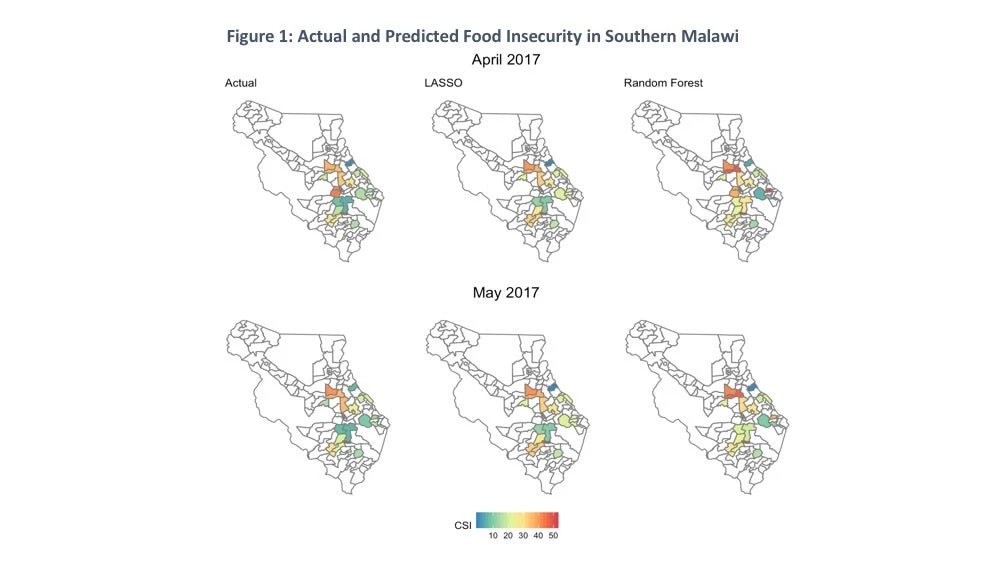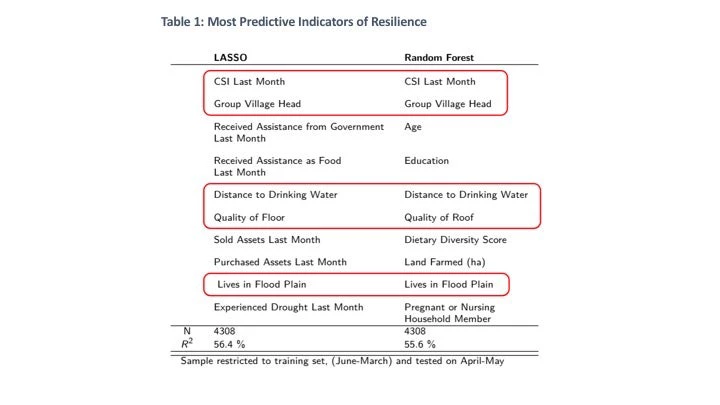One in eight people worldwide still go to bed hungry every night, and the increased severity of natural disasters like droughts only exacerbates this situation. Humanitarian agencies and development practitioners are increasingly focused on helping the most vulnerable recover from the effect of these shocks by boosting their resilience.
My Job Market Paper examines the determinants of household resilience, using machine learning algorithms to identify predictors of food insecurity. These predictors include past food insecurity, location, distance to drinking water and quality of the house. The paper uses a novel 12-month dataset collected from a series of sentinel sites in southern Malawi. It maps out, with high precision, where the most food insecure households are, informing targeting decisions.
From a policy perspective, this paper makes two key contributions:
- It outlines a method to identify and target households most in need of assistance during a humanitarian emergency.
- It demonstrates how to identify the characteristics and potential interventions that increase household resilience.
Mapping food insecurity

Figure 1 illustrates the predictive performance of the two algorithms, LASSO and Random Forest, against actual food insecurity levels in Chikwawa district, Malawi. Food insecurity is measured using the Coping Strategies Index (CSI), a tool developed by the World Food Program to rapidly measure food insecurity during a humanitarian emergency. The LASSO and Random Forest algorithms perform relatively well in terms of predictive accuracy, with an R 2 of 56.4% and 55.6%, respectively. The zones of high insecurity tend to be relatively concentrated in specific communities. However, even within these communities the predictive algorithms differentiate between food secure and food insecure households, an advantage over geographic targeting.
These maps can inform the decision making of humanitarian assistance providers.
Resilience as a predictor of food insecurity
The top ten performing variables are listed in table 1. Five of the top ten variables overlap or are very similar. The previous month’s CSI is the best predictor in both cases, followed closely by geographic location as indicated by group village head. Other good predictors include the household’s distance to drinking water, the quality of their home and whether they live in a floodplain.

Low burden, sentinel site data
The sentinel site data itself is an innovation in development research, where annual or biannual rounds of data collection are the norm. It draws on the network of early warning sites set up by FEWS Net, which uses market price data and remote sensing to predict zones of food insecurity. As a research team, we wanted to collect high frequency data at the household level. In collaboration with Catholic Relief Services (CRS) we piloted the Measuring Indicators for Resilience Analysis (MIRA) data collection protocol.
This data collection protocol relied on local enumerators equipped with smartphones. Every month they administered the brief 10 -15 minute survey to their neighbors. This approach dramatically reduced the expense of data collection and month-on-month attrition. The region selected, Chikwawa district in Southern Malawi, was suffering from the effects of a drought caused by a particularly strong El-Nino oscillation, leading to widespread crop failure and food shortages.
How might this be useful?
- As a Targeting Tool: This research taps into a growing literature on improved Proxy Means Testing, or PMT. PMT seeks to identify poor households with high probability, based on a set of readily observable and therefore easy to collect characteristics. Research published in the World Bank Economic Review shows how machine learning can improve PMT performance. In the context of a humanitarian emergency, where both data and time are scarce, such algorithms can prove useful to decision making.
- For Impact Evaluation: many resilience-oriented interventions use a somewhat ad-hoc set of indicators, informed by prior knowledge and sometimes validated through community consultation. Instead, the above approach narrows down the set of household characteristics based on their predictive merits.
As a next step, our research team is working with CRS to set in place a system of sentinel sites, providing both early warning of a humanitarian emergency and valuable data for analysis. We are particularly interested in tracking the onset of Fall Army Worm, a pest which can devastate harvests.
A particularly promising line of research is in contributing to improved Proxy Means Targeting in the context of natural disasters, or Post-Disaster PMT. By combining sentinel site data to geo-spatial and phone record data, researchers can calibrate the latter and use it to predict post-disaster food insecurity when on-the-ground data is unavailable.


Join the Conversation